 0555-6768298
0555-6768298
 0555-6768298
0555-6768298
Jeśli masz pytania lub sugestie, zostaw nam wiadomość, a my odpowiemy tak szybko, jak to możliwe!
Skontaktuj się z nami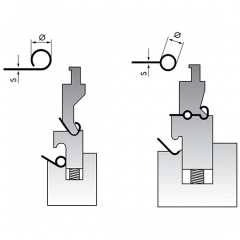
Zalety Produkcja w dwóch lub trzech skokach Redukcja śladów dzięki dociskowi sprężynowemu Aktywne komponenty są hartowane Wysoka powtarzalność dzięki zintegrowanemu zderzakowi Testowanie działania i regulacja poprzez zagięcia próbne - z arkuszami próbnymi Odpowiednie dla Grubość materiału do minimum 4,0 mm średnica wewnętrzna: 2,5 mm x grubość materiału dla stali i aluminium 3,0 mm x grubość materiału dla stali nierdzewnej
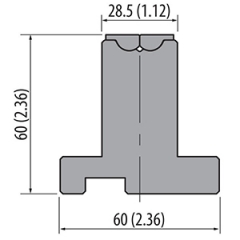
Prasa krawędziowa rolla-v matrycuje bez zarysowań, najlepiej przy zginaniu nałożyć folię na powierzchnię przedmiotu obrabianego. a my polecimy Ci odpowiedni rozmiar matrycy roll-v w zależności od wyginanej płyty.

Regulowane matryce typu Shim Regulowane dolne matryce można uznać za jeden z najbardziej wszechstronnych dodatków do prasy krawędziowej. Za pomocą tego typu narzędzia można rozmieścić otwory od 6,35 mm do 381 mm. Przekładki są dostarczane w celu wykonania wymaganego otworu. Szczelinowe elementy dystansowe umożliwiają łatwe wyjmowanie w celu zmiany otworu matrycy. Gdy nie są używane, elementy dystansowe są umieszczane po bokach bloku matrycy. Matryce te mogą być dostarczane w pełnych długościach lub podzielone na sekcje dla łatwiejszej obsługi.
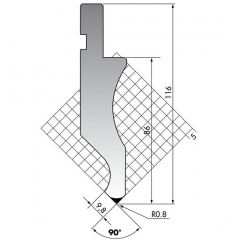
Prosty rozmiar ostrza: 835*146*26mm, 90 stopni. materiał to 42CrMo4, twardość to HRC47+/-3
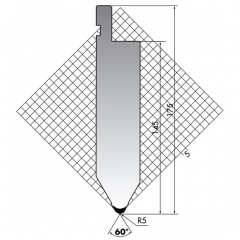
Prosty rozmiar ostrza: 835*175*40mm, 60 stopni. materiał to 42CrMo4, twardość to HRC47+/-3

Prosty rozmiar ostrza: 835*146*26mm, 90 stopni. materiał to 42CrMo4, twardość to HRC47+/-3
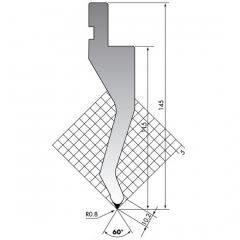
Prosty rozmiar ostrza: 835*145*32mm, 60 stopni. materiał to 42CrMo4, twardość to HRC47+/-3

Rozmiar dziurkacza na gęsiej szyi: 835*197*92mm, 88 stopni. materiał to 42CrMo4, twardość to HRC47+/-3. i wysokość 197mm, szerokość 92mm. mogą być wykonane zgodnie z życzeniem klienta.
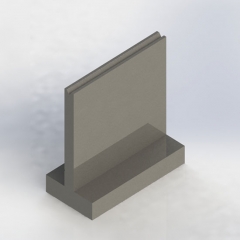
Rozmiar matrycy telewizyjnej: 835*120*60mm, V12,30 stopni. materiał to 42CrMo4, twardość to HRC52-58. i V6, V8, V10, V16, V20, V25 mogą być wykonane zgodnie z życzeniem klienta.
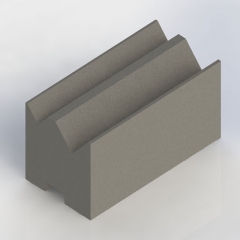
Samocentrujące matryce 2V, rozmiar to 835 * 46 * 50 mm, 88 stopni, waga to 17 kg. I możemy wykonać V5-V9, V8-V12, V12-V20, V16-V25 i inne otwory V zgodnie z grubością gięcia.
W tradycyjnych procesach gięcia, formy często pozostawiają wgniecenia lub rysy na powierzchni blachy. Problem ten jest szczególnie widoczny podczas obróbki paneli lustrzanych ze stali nierdzewnej, blach aluminiowych lub elementów dekoracyjnych, co znacznie pogarsza wygląd i ogólną wartość produktu, a czasem nawet prowadzi do przeróbek lub złomowania. Wraz ze wzrostem zapotrzebowania na jakość powierzchni w produkcji, pojawiły się narzędzia do gięcia bez zarysowań.
Rodzaje Narzędzie do prasy krawędziowej bez śladów :
Narzędzia do gięcia bez zarysowań są projektowane ze specjalnymi strukturami lub materiałami, aby zapobiegać zarysowaniom i wgnieceniom. Typowe typy to:
Narzędzia z łożyskami kulkowymi, nierysującymi blachy: Podtrzymują blachę za pomocą łożysk kulkowych, co znacznie zmniejsza tarcie, skutecznie zapobiega zarysowaniom i sprawia, że proces gięcia jest płynniejszy.
Narzędzia z mechanizmem odchylania, odporne na zarysowania: Powierzchnia podparcia może się obracać w zależności od kąta gięcia, zapobiegając uszkodzeniom. Ten elastyczny mechanizm odchylania zapewnia równomierne podparcie blachy podczas całego procesu gięcia, zapobiegając powstawaniu lokalnych wgnieceń.
Narzędzia z podkładkami poliuretanowymi, które nie rysują powierzchni: Dzięki zastosowaniu elastycznych podkładek chroniących blachę narzędzia te są szczególnie przydatne do precyzyjnej obróbki blachy o wysokiej jakości powierzchni.
Zalety narzędzi do gięcia, które nie pozostawiają zarysowań:
W porównaniu z tradycyjnymi narzędziami, formy odporne na zarysowania oferują wyraźne korzyści w obróbce blach:
Chroń powierzchnie blaszane: zapobiegaj wgnieceniom i zarysowaniom, zapewniając wysokiej jakości wygląd.
Zmniejsz koszty materiałów: Zminimalizuj przeróbki i polerowanie, zwiększając wydajność produkcji .
Wysoka adaptowalność: Nadaje się do różnych materiałów i grubości, spełniając zróżnicowane wymagania procesowe.
Wydłużenie żywotności formy: łożyska kulkowe lub konstrukcje płytkowe zmniejszają zużycie, wydłużając żywotność narzędzia.
Materiały stosowane i dziedziny przemysłu:
Narzędzia do gięcia bez zarysowań są szeroko stosowane do blach wymagających wyjątkowo wysokiej jakości powierzchni, w tym do paneli lustrzanych ze stali nierdzewnej, blach aluminiowych, blach ocynkowanych oraz powlekanych lub malowanych paneli dekoracyjnych. Znajdują one zastosowanie w wielu gałęziach przemysłu wytwórczego, takich jak:
Dekoracje wind i architektoniczne: Do paneli wind, metalowych ścian osłonowych i różnych elementów dekoracyjnych ze stali nierdzewnej.
Naczynia kuchenne i sprzęt AGD: Do produkcji obudów naczyń kuchennych, lodówek, pralek itp., zapewniających gładkie i atrakcyjne powierzchnie.
Sprzęt medyczny i precyzyjny: Do metalowych części urządzeń medycznych, przyrządów testowych i innych zastosowań wymagających ścisłych wymagań dotyczących integralności powierzchni.
Wysokiej klasy blacha niestandardowa: np. elementy lotnicze lub luksusowe wnętrza, gdzie szczegółowość i jakość powierzchni mają kluczowe znaczenie.
Podsumowując, narzędzia do gięcia bez zarysowań nie tylko poprawiają jakość powierzchni produktów, ale także pomagają firmom zajmującym się obróbką blachy obniżyć koszty produkcji i zwiększyć wydajność. W ostatnich latach firma Golin Tooling podążała z duchem czasu w dziedzinie gięcia bez zarysowań, opracowując i wprowadzając na rynek wiele narzędzi do gięcia bez zarysowań, które były sprzedawane w Europie, Ameryce Południowej i niektórych regionach Bliskiego Wschodu, ciesząc się niezmiennie uznaniem klientów. Patrząc w przyszłość, zapotrzebowanie na gięcie bez zarysowań w produkcji wysokiej klasy będzie nadal rosło, a firma Golin będzie nadal dostarczać profesjonalne i wydajne rozwiązania narzędziowe klientom na całym świecie.
 online
online 0555-6768298
0555-6768298 0555-6769126
0555-6769126 sales2@cngolin.cn
sales2@cngolin.cn +86 18251802252
+86 18251802252